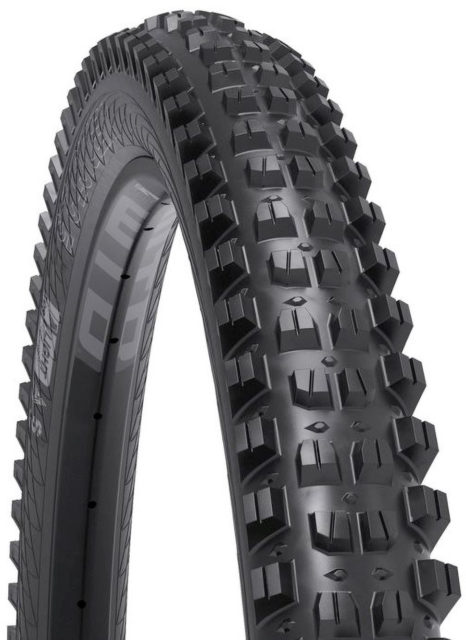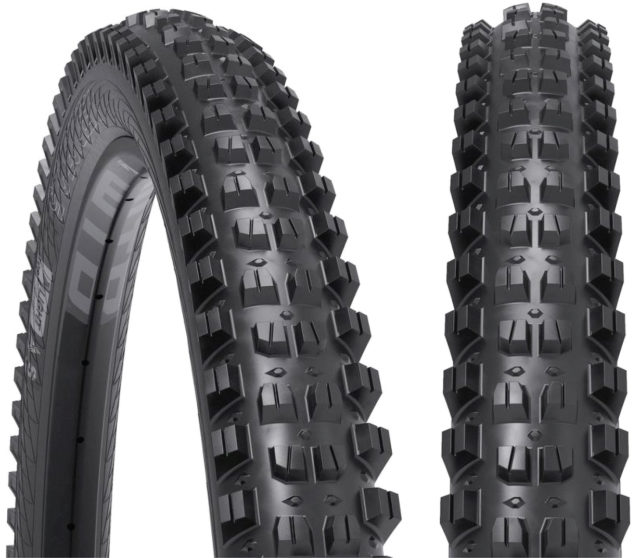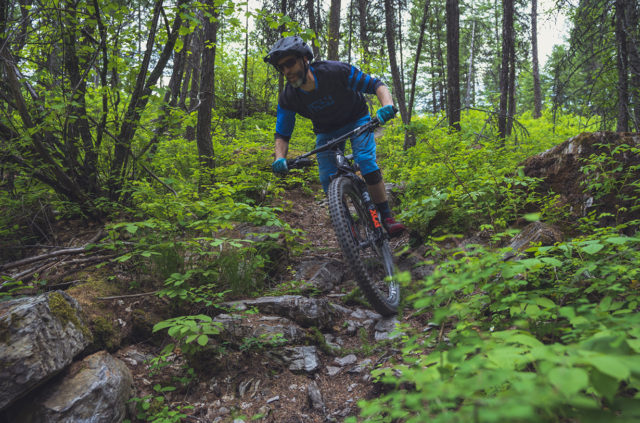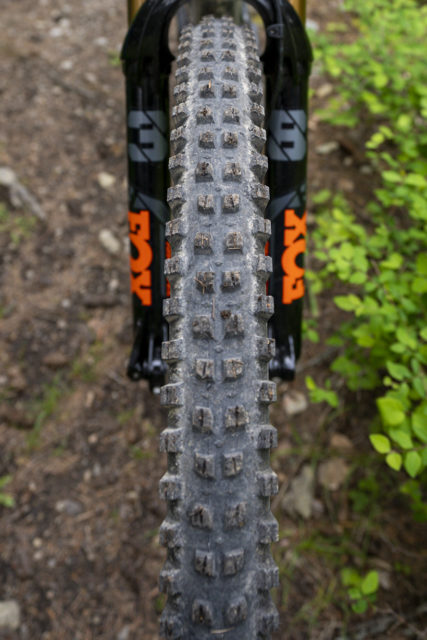WTB Verdict and Judge
Stated Dimensions:
- Verdict: 29” x 2.5” (27.5” x 2.5” available)
- Judge: 29” x 2.4” (27.5” x 2.4” available)
Measured Width (on 30 mm internal rim):
- Verdict
- 2.54″ / 64.6 mm tread width at widest point
- 2.33″ / 59.2 mm casing width
- Judge
- 2.33″ / 59.3 mm tread width at widest point
- 2.14″ / 54.3 mm casing width
Casing tested: TCS Tough (Verdict & Judge)
Rubber Compound tested:
- Verdict: High Grip
- Judge: Fast Rolling
Blister’s Measured Weight:
- Verdict: 1277 grams
- Judge: 1293 grams
Mounted to: Specialized Enduro / Enve M730 Wheels
Intended Use: Loam Saw / Loose / Dirt / Rocky / Wet
MSRP: $83.95 (as tested; pricing varies based on options)
Reviewer: 5’9”, 155 lbs
Test Location: Whitefish, MT
Duration of Test: ~40 rides / ~500 miles


Intro
The Judge and Verdict are some of the newer tires in WTB’s lineup, and they’re decidedly at the meaty, high-traction end of the spectrum. Of course, WTB isn’t new to big, knobby tires — the Vigilante is a popular option, and not too long ago, the Trail Boss got re-worked with bigger, blockier knobs.
But the Judge and Verdict differentiate themselves from those tires by their knob patterns, which get rid of the transitional knobs found on many of WTB’s other tires. And that positions the Judge and Verdict as tires with a more singular focus on traction, particularly in corners.
While they’re different tires with different tread patterns, WTB recommends the Verdict and Judge as a pair, with the Verdict up front and Judge out back, so that’s how I’ve been using them for the past few months.
Design, Construction, & Options
Both the Judge and the Verdict come in 27.5 and 29” sizes, but they only come in one width each — a 2.4” for the Judge, and a 2.5” for the Verdict. As the sizes suggest, the Verdict is intended to be a front tire while the Judge is intended to be a rear tire. The Verdict is also available in a “wet” version, which has even taller, spikier knobs.

The Judge is only available in WTB’s Tough casing (2 ply, 60 tpi each, folding bead), while the Verdict is available in both the Tough casing as well as their Light casing with Slashguard (single ply, 60 tpi, with a nylon insert through the whole sidewall).
The Verdict is only offered in a “High Grip” rubber compound, which uses WTB’s “Tritec” triple compound. This is a fairly standard triple-compound construction: a hard base compound that gives the knobs their basic shape and support, which is then capped with a softer compound on the center knobs, and an extra-soft compound on the side knobs.

The Judge is offered in both a “High Grip” and “Fast Rolling” version. The High Grip compound is the same as on the Verdict, while the Fast Rolling is still a triple compound, just with firmer capping rubber used on the middle and side knobs. As the names imply, the firmer rubber will roll faster (and last longer), but it doesn’t grip roots and rocks quite as well. For this review, I’ve been testing the Verdict with the High Grip compound and Tough casing, and the Judge with the Fast Rolling compound and Tough casing.
In terms of the tread design, the Verdict and Judge have a clearly defined channel between the center knobs and the side knobs. For more words than you probably want to read on this subject, check out our Tires 101 article (and stay tuned for a new Tires 101 article on compounds and casings, as well as one that includes several direct comparisons).
But to distill it down, some tires, like the WTB Vigilante, have knobs spread across the entire width, so as you lean the bike over into a corner, there’s a smooth transition from the center knobs to the side knobs. Other tires, like the Verdict and Judge, have a defined, empty channel between the center and side knobs, so there’s a middle lean angle with less traction — the center knobs have disengaged, but the side knobs haven’t fully engaged yet. Generally speaking, tires without transitional knobs can dig harder into a corner, but they can feel “drifty” at mild lean angles.
Mounting / Installation
I’ve mounted the Verdict and Judge on a couple different wheelsets, and I’d say the tires are moderately tight. Getting them on was, for the most part, not too bad, and the tight bead meant that they sealed up tubeless really easily. On some wheels, removing the tires was uneventful, on others, they were a bit stubborn. On the whole, I’d call them slightly tighter than average, but not rising to the level of “throw wrenches in frustration.”
On the Trail
On the bike, the Verdict and Judge are definitely big, knobby tires. In terms of their actual, measured size, they’re reasonably close to being true to size. The 2.5” Verdict measures out to about 2.55” (on a 30 mm rim), while the 2.4” Judge is more like 2.35” (again, on a 30 mm rim). But the knobs on both tires are noticeably tall — they just look like they want to sink into soft loam and tear it to shreds.

And indeed, that’s very clearly where these tires perform best — in soft soil. The trails in my neck of the woods are more loam than sand, but I’d imagine these tires would do well in any soft condition. I’d actually argue that they might even work a bit better in sand than in the loam I’ve had them in (more on that below).
Throughout my time on these tires, regardless of conditions, they were pleasantly predictable. Every tire design has its little nuances where it works better or worse, but if it’s unpredictable, that doesn’t really matter. The Verdict and Judge are both entirely predictable, and I never found myself skittering out of a corner or washing the front tire when I didn’t see it coming.
The profile of these tires is fairly square, and the side knobs are a bit more upright than some of the other tires in this category (e.g. the Maxxis DHF / DHR II, or a Specialized Butcher). That, combined with the fact that the Judge and Verdict’s side knobs are pretty tall, means that you don’t have to lean quite as far over to get those side knobs engaged. So while these are still tires that don’t have transitional knobs, that drifty lean angle where you’re in between the center and side knobs is a little less pronounced on these tires than it is with something like a DHF.
In some situations, that’s a good thing — on more moderate corners, it’s easier to get the side knobs fully engaged. And on off-camber side hills where you’re constantly fighting to keep the bike from slipping off the low side of the trail, it’s a bit easier to keep the Verdict and Judge’s side knobs hooked up.
The downside is that, at high lean angles in hard corners, it’s possible to lean past the side knobs. And this comes back to my comment about how these tires might be even better in sand than in loam — loam usually feels a bit more supportive and it’s a little easier to lean way over and trench through a corner. In those situations, I wish the Judge and Verdict’s side knobs were a little less upright (and I could, therefore, lean harder into them). But in sand, where it’s difficult to use really dramatic lean angles during a turn, I think the slightly more upright side knobs on the Judge / Verdict would actually work really well. Admittedly though, this is speculative since I haven’t spent a lot of time using these tires in sandy conditions.
Sand and loam aside, the Judge and Verdict clearly prefer to stay in softer conditions. The harder packed the trail is, the more those big knobs start squirming around. And to be clear, both versions of WTB’s triple-compound construction do a pretty good job of keeping the knobs from being too squirmy, but tall knobs on hard dirt make for squirmy cornering, regardless of the rubber compound used.
Cornering is one thing, but where I was actually really impressed by the Judge and Verdict was under hard braking. If I need to quickly slow things down, these are some of the best tires I’ve ever ridden. And that shouldn’t come as too much of a surprise — big, blocky, tall knobs — with a triple-compound construction that keeps them from being too squirmy — is a recipe for digging in while on the stoppers. But just to confirm expectations: yes, they are really good at slowing down.

And, also as expected, the flip side of that is that these are not particularly fast-rolling tires. They’re actually a little better than I expected, but expectations were low. I’d say they’re a bit slower than average for tires in this class.
In terms of wet traction, I’d say they’re average-ish. The big knobs grip well in muck and they’re spaced out enough that they do a good job of shedding mud. But, despite the triple-compound construction, the WTB High Grip and Fast Rolling rubber compounds don’t feel quite as soft and grippy as some of the truly tacky tires on the market (E.g., a Maxxis Super Tacky, or even a MaxxGrip), so the Judge / Verdict give up a bit of ground in terms of sticking to wet roots and rocks.
Comments on WTB Verdict vs. WTB Judge
This whole time I’ve been speaking in generalities about both the Verdict on the front and the Judge on the rear, and to be sure, they pair well together and generally ride similarly. But they’re obviously different tires with different knob patterns and different widths.
The Verdict is the more “aggressive” of the two — aside from being wider at 2.5″, its tread pattern is more open, and the knobs are “spikier.” It really resembles a slightly toned-down mud tire (which is essentially what it is), while the 2.4″ Judge is a somewhat more traditional rear tire with alternating blocky paddles (which are great for hard braking).
That same open tread design makes the Verdict slightly better at clearing mud, although really, both tires are very good in that regard.
In terms of cornering, as I mentioned above, I felt like in hard corners at high lean angles, I could lean past the side knobs of both tires. This was more noticeable in the rear with the Judge. At a guess, this is probably just due to the width difference — the wider Verdict creates a more rounded profile on the rim, which (at least with this tire) helps in hard corners.
Comparisons: WTB Verdict & Judge vs. Maxxis Minion DHF & DHRII
There are a lot of different tires out there that the Verdict / Judge combo could be compared to, but the Maxxis DHF / DHRII pairing is pretty clearly the benchmark in this category, and is consequently the obvious comparison.
Purely in terms of construction, WTB’s Tough casing that I rode falls somewhere between the Maxxis DoubleDown and DH casings, and the Tough casing sits in between those examples in terms of both weight and durability as well. As for the rubber compound, both WTB (with Tritec) and Maxxis (with 3C) are using triple-compound designs. I’d say Maxxis’ 3C MaxxGrip is a bit softer / grippier / faster wearing than WTB’s High Grip. And I’d say WTB’s Fast Rolling compound seems pretty comparable to Maxxis’ 3C MaxxTerra compound.

On the trail, the gap from the center knobs to the side knobs is more distinct and noticeable on the Maxxis pairing — the Maxxis side knobs are angled a little farther over toward the sidewall. The result is that the DHF / DHRII drifts a bit more at moderate lean angles, but it’s harder to lean past the side knobs, which is sometimes a problem with the Verdict / Judge.
So I’d say the WTB Verdict and Judge do a bit better in mild corners and crossing funny, off-camber bits of trail, but the Maxxis DHF / DHRII combo does better in hard corners where you’re really leaned over and asking a lot of your side knobs. I’d also say the Maxxis tires feel a bit less squirmy while cornering on harder packed trails, but neither of the options are spectacular in that situation.
While both the Maxxis and the WTB tires are solid under hard braking, the WTB combo wins out here — they’re excellent for slowing you down quickly.
Durability
As I mentioned above, I’ve been running Tough casings on both the Verdict and Judge, with the softer High Grip compound in the front on the Verdict, and the harder Fast Rolling compound in the rear on the Judge. So far I haven’t had any flats of any kind, despite plenty of rim strikes. I’m not running any sort of foam insert in the tires, although, for most of my time on them, they were mounted on Enve M730 rims, which have Enve’s protective rim strip (read more about that in my long-term review of the M730).
I’ve put quite a few slices in the rubber on the sidewall and around the tread, but so far none of those have made it through the casing. No sealant or air has seeped out, so the slices are all inconsequential.

In terms of tread wear, they’re both holding up well. I’d guess that I have around 500 miles on the tires and while they’re definitely showing wear, they’re not completely toasted. The side knobs aren’t ripping off or becoming excessively undercut, and the center knobs aren’t wearing down overly quickly. It’s also worth noting that the High Grip compound Verdict on the front is wearing at about the same rate as the Fast Rolling compound Judge on the rear, which is nice.

Bottom Line
The Verdict and Judge are both solid offerings from WTB. While they’re roughly similar to plenty of other tires on the market, they’re still able to differentiate themselves enough to warrant consideration.
The Verdict and Judge are defined by their aggressively tall, spikey knobs, which makes them a solid choice for anyone who spends a lot of time in soft sand or trenching through loam. And those same attributes make them one of the better options for a mud tire that can still function pretty well when things dry out a bit. They’re some of the best tires I’ve ever ridden when it comes to braking, and their squared-off design makes it easier to get the side knobs dug in when the bike isn’t leaned way over, compared to some other options that similarly lack transitional knobs.
All in all, anyone who rides a lot of wet conditions or who is looking for a soft-soil, loam-saw of a tire should give the Verdict and Judge a look. And anyone who likes the idea of a tire without transitional knobs, but who wants something that’s a little less drifty while leaning into corners than a tire like the DHF, should put these on the list.

Hi Noah,
good comprehensive review as always, reading between the lines I guess for a rear the DHR2 in Maxxterra (DD?) still wins. Mostly.
I think you perhaps got the tyre compounds the wrong way around here:
“For this review, I’ve been testing the Verdict with the Fast Rolling compound and Tough casing,
and the Judge in the only available combo: High Grip compound and Tough casing.”
It’s the Judge that’s available in both Fast Rolling compound & High Grip compound, right – and the Verdict thats only in High Grip compound?
Just thought you may have missed that switcheroo?
Yeah, personally I’d probably still lean towards a DHR2 – I think it hooks up better in the corners. The Judge is better under hard braking, but I prefer the better cornering of the DHR2.
And yeah – good catch! I had the names / compounds reversed there. Now fixed.
Nice one Noah, thanks,
I’m gonna take it that you prefer the DHR2 rear, overall, and follow that advice.
I’ve liked the 2.3 version on the back as long as its not too muddy.
I ride a Geometron so its LONG and slack and likes to be pushed over in corners which I feel means I’ll ‘need’ that “better” DHR2 edge.
Probably the EXO+ WT on a 30 rim.
Some say the WT DHR2 has a little less ‘edge channel’ so the side knobs engage sooner, which I guess means the difference between Judge and DHR2 WT is less pronounced than with Judge v DHR 2.3
thanks man, always good to have solid advice on rubber
I think that’s all a pretty accurate take, although I’d say there’s still a noticeable difference between the Judge and DHR2 WT. The side knobs on the DHR2 (all versions) are just wrapped a bit further over onto the sidewall, which I think makes them bite better at higher lean angles (compared to the Judge).
thanks for that, appreciate the personal touch
Minions – often copied never bettered.
Hi Noah,
Do you think the square profile of the Judge would be remedied by mounting it on a 25mm rim? I only have a 25mm wheelset available and would like to try this tire, but I’m curious what you think about it.